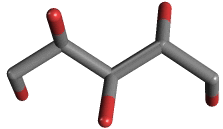|
D-ARABINITOL |
| Synonyms. D-Arabinitol; (2R,4R)-1,2,3,4,5-Pentanepentol; D-(+)-Arabitol; (2R,4R)-pentane-1,2,3,4,5-pentol; D-Lyxitol; |
|
|
| PRODUCT IDENTIFICATION | |
|
CAS RN |
488-82-4 |
|
EINECS RN |
207-686-2 |
|
FORMULA |
C5H12O5 |
|
MOLE WEIGHT |
152.15 |
|
H.S CODE |
2905.49.4000 |
|
SMILES |
OC[C@@H](O)[C@@H](O)[C@H](O)CO |
|
CLASSIFICATION |
Carbohydrate |
|
EXTRA NOTES |
Arabitol or arabinitol is a sugar alcohol. It can be formed by the reduction of either arabinose or lyxose. Some organic acid tests check for the presence of D-arabinitol, which may indicate overgrowth of intestinal parasites such as Candida albicans or other yeast/fungus species (wikipedia) |
|
|
| PHYSICAL AND CHEMICAL PROPERTIES | |
|
PHYSICAL STATE. |
white crystalline powder |
|
MELTING POINT |
100 ~ 103 C |
|
BOILING POINT |
|
|
DENSITY |
|
|
SOLUBILITY IN WATER |
Miscible |
| SOLVENT SOLUBILITY |
|
|
VAPOR DENSITY |
|
|
log P(octanol-water) |
|
|
VAPOR PRESSURE |
|
|
AUTOIGNITION TEMP |
|
| pK |
|
|
REFRACTIVE INDEX |
|
|
FLASH POINT |
|
|
|
| STABILITY AND REACTIVITY | |
| STABILITY | Stable under normal conditions. |
|
INCOMPATIBLE MATERIALS |
Strong oxidizing agents |
| POLYMERIZATION |
Has not been reported |
|
NFPA RATINGS |
Health: 0, Flammability: 0, Reactivity: 0 |
|
|
| EXTERNAL LINKS & GENERAL DESCRIPTION |
|
USA.gov - D-Arabinitol Wikipedia Linking - Arabinitol Google Scholar Search - D-Arabinitol U.S. National Library of Medicine - D-Arabinitol PubChem Compound Summary - D-Arabinitol KEGG (Kyoto Encyclopedia of Genes and Genomes) - D-Arabinitol http://www.ebi.ac.uk/chebi/ - D-Arabinitol http://www.ncbi.nlm.nih.gov/ - D-Arabinitol Material Safety Data Sheet - D-Arabinitol EPA - Substance Registry Services - D-Arabinitol http://www.sigmaaldrich.com/ |
|
|
| SALES SPECIFICATION | |
|
APPEARANCE |
white crystalline powder |
|
ASSAY |
98% min |
|
MELTING POINT |
128 ~ 132 C |
| OPTICAL ROTATION |
+7° ~ +9° |
|
LOSS ON DRYING |
1% max |
|
HEAVY METALS |
10ppm max |
|
|
| TRANSPORT & REGULATORY INFORMATION | |
|
UN NO. |
|
| HAZARD CLASS |
|
| PACKING GROUP | |
|
|
| SAFETY INFORMATION | |
|
HAZARD OVERVIEW |
GHS (Globally Harmonised System) Classification: Not a dangerous substance. Potential Health Effects: Eyes - May cause eye irritation. Skin - May be harmful if absorbed through skin May cause skin irritation. Inhalation - May be harmful if inhaled. May cause respiratory tract irritation. Ingestion - May be harmful if swallowed. |
| HAZARD CODES |
|
|
RISK PHRASES |
|
|
SAFETY PHRASES |
|
|
|
| PACKING |
|
Preserved in light-resistant and well-closed bottles |
|
|
